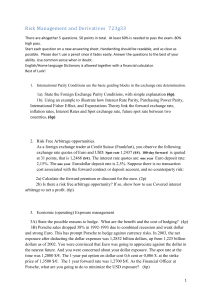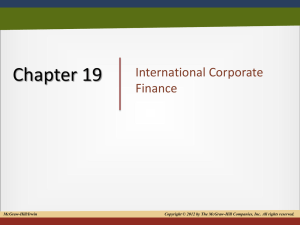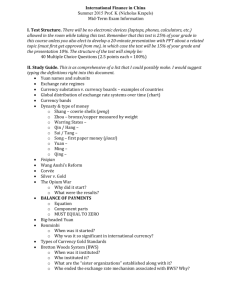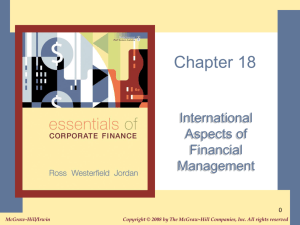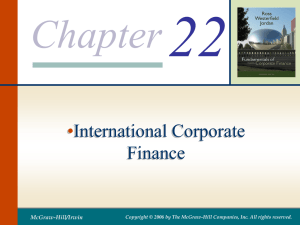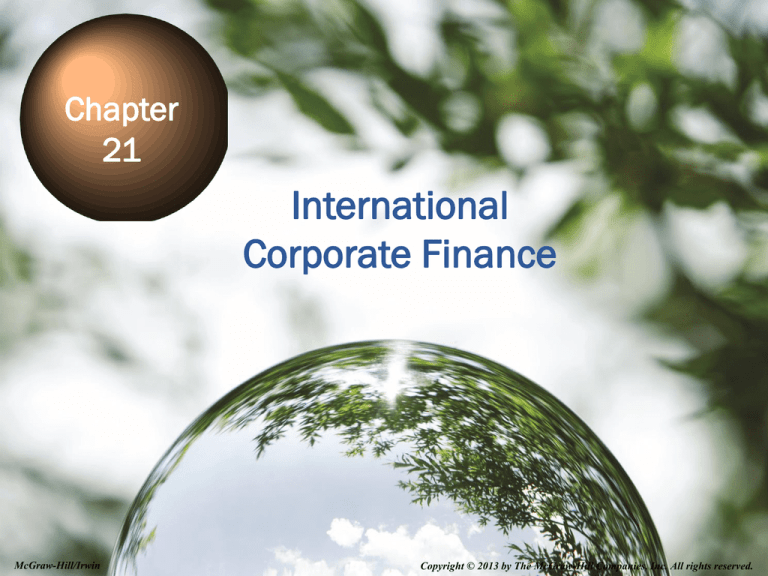
Chapter
21
International
Corporate Finance
21-1
McGraw-Hill/Irwin
Copyright © 2013 by The McGraw-Hill Companies, Inc. All rights reserved.
Chapter Outline
• Terminology
• Foreign Exchange Markets and
Exchange Rates
• Purchasing Power Parity
• Interest Rate Parity, Unbiased Forward
Rates, and the International Fisher
Effect
21-2
Chapter Outline
(Continued)
• International Capital Budgeting
• Political Risk
21-3
Chapter Outline
• Terminology
• Foreign Exchange Markets and
Exchange Rates
• Purchasing Power Parity
• Interest Rate Parity, Unbiased Forward
Rates, and the International Fisher
Effect
21-4
International Currency
21-5
International Finance
Terminology
American Depositary Receipt (ADR)
Cross-rate
Eurobond
Eurocurrency (Eurodollars)
Foreign bonds
Gilts
London Interbank Offer Rate (LIBOR)
21-6
Swaps
Domestic Financial
Management and International
Financial Management
Considerations in International Financial Management
Need to consider the effect of exchange rates when
operating in more than one currency
Must consider the political risk associated with actions of
foreign governments
More financing opportunities when you consider the
international capital markets, which may reduce the firm’s
cost of capital
21-7
Chapter Outline
• Terminology
• Foreign Exchange Markets and
Exchange Rates
• Purchasing Power Parity
• Interest Rate Parity, Unbiased Forward
Rates, and the International Fisher
Effect
21-8
Global Capital Markets
The number of exchanges in foreign countries
continues to increase, as does the liquidity on those
exchanges
Exchanges that allow for the flow of capital are
extremely important to developing countries
The United States has one of the most developed
capital markets in the world, but foreign markets
are becoming more competitive and are often
willing to try more innovative ways to do business
21-9
Exchange Rates
The price of one
country’s currency
in terms of another
Most currency is
quoted in terms of
dollars
21-10
Exchange Rates: The Key to
this Chapter!
Consider the following quote:
Euro:
1.2695
.7877
The first number (1.2695) is how many U.S.
dollars it takes to buy 1 Euro
The second number (.7877) is how many
Euros it takes to buy $1
21-11
The two numbers are reciprocals of each
other (1/ 1.2695 = . 7877)
Example 1: Exchange Rates
Suppose you have $10,000.
You can buy Japanese Yen today at the
exchange rate of 108.21
How many Japanese
Yen can you buy?
Buy $10,000(108.21)
= 1,082,100 Yen
21-12
Work the Web
Thinking about going to Mexico for
spring break or Japan for your
summer vacation?
How many pesos or yen can you get
in exchange for $1,000?
Click on the web surfer to find out
21-13
Example: Triangle Arbitrage
We observe the following quotes:
1 Euro per $1
2 Swiss Franc per $1
0.4 Euro per 1 Swiss Franc
What is the cross rate?
(1 Euro / $1) / (2 SF / $1)
= 0.5 Euro / SF
21-14
Example: Triangle Arbitrage
We have $100 to invest: buy low,
sell high
Buy $100(1 Euro/$1) = 100 Euro
use Euro to buy SF
Buy 100 Euro / (.4 Euro / 1 SF) = 250 SF
use SF to buy dollars
Buy 250 SF / (2 SF/$1) = $125
21-15
Make $25 risk-free!
Types of Transactions
Spot trade – exchange currency
immediately
Spot rate – the exchange rate for an
immediate trade
21-16
Types of Transactions
Forward trade – agree today to exchange
currency at some future date and some
specified price (also called a forward
contract)
Forward rate – the exchange rate specified in
the forward contract
If the forward rate is higher than the spot
rate, the foreign currency is selling at a
premium (when quoted as $ equivalents)
21-17
If the forward rate is lower than the spot rate,
the foreign currency is selling at a discount
Chapter Outline
• Terminology
• Foreign Exchange Markets and
Exchange Rates
• Purchasing Power Parity
• Interest Rate Parity, Unbiased Forward
Rates, and the International Fisher
Effect
21-18
Absolute Purchasing
Power Parity (PPP)
The price of an item should be the same in real
terms, regardless of the currency used to purchase
it.
21-19
Absolute Purchasing
Power Parity
Requirements for absolute PPP to hold:
1. Transaction costs are zero
2. No barriers to trade (no taxes,
tariffs, etc.)
3. No difference in the commodity
between locations
Note: For most goods, absolute PPP rarely holds in
practice
21-20
Relative Purchasing
Power Parity
Provides information about what causes changes in
exchange rates
The basic result is that exchange rates depend on
relative inflation between countries
E(St ) = S0[1 + (hFC – hUS)]t
Because absolute PPP doesn’t hold for many goods, we
will focus on relative PPP from here on out
21-21
Example: Relative PPP
Suppose the Canadian spot exchange rate is 1.18 Canadian
dollars per U.S. dollar. U.S. inflation is expected to be 3%
per year, and Canadian inflation is expected to be 2%.
Do you expect the U.S. dollar to appreciate or depreciate
relative to the Canadian dollar?
Since expected inflation is higher in the U.S., we
would expect the U.S. dollar to depreciate relative to
the Canadian dollar.
21-22
Example: Relative PPP
Suppose the Canadian spot exchange rate is 1.18
Canadian dollars per U.S. dollar. U.S. inflation is
expected to be 3% per year, and Canadian inflation is
expected to be 2%.
What is the expected exchange rate in one year?
E(S1) = 1.18[1 + (.02 - .03)]1 = 1.1682
21-23
Covered Interest Arbitrage
Examines the relationship between spot rates,
forward rates, and nominal rates between countries
21-24
Covered Interest Arbitrage II
Again, the formulas will
assume that the exchange
rates are quoted in terms of
foreign currency per U.S.
dollar
The U.S. risk-free rate is
assumed to be today’s T-bill
rate
21-25
Example: Covered Interest
Arbitrage
Consider the following information:
21-26
S0 = .8 Euro / $
RUS = 4%
F1 = .7 Euro / $
RE = 2%
What is the arbitrage opportunity?
1. Borrow $100 at 4%
2. Buy $100(.8 Euro/$) = 80 Euro and invest at 2%
for 1 year
3. In 1 year, receive 80(1.02) = 81.6 Euro and
convert back to dollars
4. 81.6 Euro / (.7 Euro / $) = $116.57 and repay
loan
5. Profit = 116.57 – 100(1.04) = $12.57 risk free
Chapter Outline
• Terminology
• Foreign Exchange Markets and
Exchange Rates
• Purchasing Power Parity
• Interest Rate Parity, Unbiased Forward
Rates, and the International Fisher
Effect
21-27
Interest Rate Parity
Based on the previous example, there must be a
forward rate that would prevent the arbitrage
opportunity.
Interest rate parity defines what that forward rate
should be:
F1
(1 RFC )
Exact :
S0
(1 RUS )
F1
Approx. :
1 ( RFC RUS )
S0
21-28
Unbiased Forward Rates
The current forward rate is an unbiased estimate of the
future spot exchange rate
This means that, on average, the forward rate will equal
the future spot rate
21-29
Unbiased Forward Rates II
21-30
If the forward rate is consistently too high:
Those who want to exchange yen for dollars
would only be willing to transact in the future
spot market
The forward price would have to come down
for trades to occur
If the forward rate is consistently too low:
Those who want to exchange dollars for yen
would only be willing to transact in the future
spot market
The forward price would have to come up for
trades to occur
Uncovered Interest Parity
What we know so far:
PPP: E(S1) = S0[1 + (hFC – hUS)]
IRP: F1 = S0[1 + (RFC – RUS)]
UFR: F1 = E(S1)
Combining the formulas we get:
E(S1) = S0[1 + (RFC – RUS)] for one period
E(St) = S0[1 + (RFC – RUS)]t
21-31
International Fisher Effect
Combining PPP and UIP we can get the
International Fisher Effect:
RUS – hUS = RFC – hFC
The International Fisher Effect tells us that the real
rate of return must be constant across countries
If it is not, investors will move their money to the
country with the higher real rate of return
21-32
Chapter Outline
International Capital Budgeting
Political Risk
21-33
Overseas Production:
Alternative Approaches
Home Currency Approach
Estimate cash flows in foreign currency
Estimate future exchange rates using UIP
Convert future cash flows to dollars
Discount using domestic required return
21-34
Home Currency Approach
Your company is looking at a new project in
Mexico. The project will cost 9 million pesos.
The cash flows are expected to be 2.25
million pesos per year for 5 years. The current
spot exchange rate is 10.91 pesos per dollar.
The risk-free rate in the US is 4%, and the
risk-free rate in Mexico 8%. The dollar
required return is 15%.
Should the company make the
investment?
21-35
Overseas Production:
Alternative Approaches
Foreign Currency Approach
Estimate cash flows in foreign currency
Use the IFE to convert domestic required return to
foreign required return
Discount using foreign required return
Convert NPV to dollars using current spot rate
21-36
Foreign Currency Approach
Use the same information as the previous example
to estimate the NPV using the Foreign Currency
Approach
Relative inflation difference from the International Fisher
Effect is 8% - 4% = 4%
Required Return = (1.15*1.04 – 1) = 19.6%
PV of future cash flows = 6,788,537 pesos
NPV = 6,788,537 – 9,000,000
= -$2,211,463 pesos
NPV = -2,211,463 / 10.91 = -$202,701
21-37
Repatriated Cash Flows
In certain countries, some of the cash generated
from a foreign project must remain in the foreign
country due to restrictions on repatriation
21-38
Repatriated Cash Flows II
Repatriation can occur in several
ways
Dividends to parent company
Management fees for central services
Royalties on the use of trade names
and patents
21-39
Short-Run Exposure
It is the risk from day-to-day fluctuations in exchange
rates and the fact that companies have contracts to buy
and sell goods in the short-run at fixed prices
21-40
Short-Run Exposure II
Managing Short-run exposure risk
Enter into a forward agreement to guarantee the exchange
rate
Use foreign currency options to lock in exchange rates if
they move against you, but benefit from rates if they move in
your favor
21-41
Long-Run Exposure
Long-run fluctuations come from
unanticipated changes in relative
economic conditions
Could be due to changes in labor
markets or governments
More difficult to hedge against
21-42
Long-Run Exposure II
Try to match long-run inflows
and outflows in the currency
Borrowing in the foreign
country may mitigate some of
the problems
21-43
Translation Exposure
Income from foreign operations must be translated
back to U.S. dollars for accounting purposes, even if
foreign currency is not actually converted back to
dollars.
21-44
Translation Exposure II
If gains and losses from this translation flowed through
directly to the income statement, there would be
significant volatility in EPS.
21-45
Translation Exposure III
Existing accounting regulations require that
all cash flows be converted at the prevailing
exchange rates with currency gains and losses
accumulated in a special account within
shareholders equity.
21-46
Managing Exchange
Rate Risk
Large multinational firms may need to
manage the exchange rate risk associated
with several different currencies
The firm needs to consider its net exposure
to currency risk instead of just looking at
each currency separately
21-47
Managing Exchange
Rate Risk II
Hedging individual currencies could be
expensive and may actually increase
exposure
21-48
Chapter Outline
• International Capital Budgeting
• Political Risk
21-49
Political Risk
Changes in value due to political actions in the
foreign country
Investment in countries that have unstable
governments should require higher returns
21-50
Political Risk
The extent of political risk depends on the nature of
the business
The more dependent the business is on other
operations within the firm, the less valuable it is to
others
Natural resource development can be very valuable
to others, especially if much of the ground work in
developing the resource has already been done
Local financing can often reduce political risk
21-51
Ethics Issues
You are “stuck” in a customs line entering into a
foreign country. A $20 “expediting fee” could be paid
to forgo the line and enter immediately.
What do you do?
21-52
Quick Quiz
What does an exchange rate tell us?
What is triangle arbitrage?
What are absolute purchasing power parity and
relative purchasing power parity?
What are covered interest arbitrage and interest rate
parity?
What are uncovered interest parity and the
International Fisher Effect?
21-53
Quick Quiz, Part Deux
What are the two methods for international capital
budgeting?
What is the difference between short-run interest rate
exposure and long-run interest rate exposure? How
can you hedge each type?
What is political risk, and what types of businesses face
the greatest risk?
21-54
Comprehensive Problem
Assume that one U.S. dollar buys 115
Japanese Yen, and one U.S. dollar buys
.54 Pound Sterling.
What must the dollar – pound exchange
rate be in order to prevent triangular
arbitrage (ignore transaction costs)?
21-55
Terminology I
•
•
•
•
•
•
•
•
21-56
Exchange rate
Spot trade
Forward trade
Absolute Purchasing Power Parity
Relative Purchasing Power Parity
Arbitrage
Interest rate parity
International Fisher Effect
Terminology II
•
•
•
•
•
21-57
Repatriated Cash Flows
Short-run Exposure
Long-run Exposure
Translation Exposure
Political Risk
Formulas I
Relative Purchasing Power Parity
E(St ) = S0[1 + (hFC – hUS)]t
Interest Rate Parity
F1
(1 RFC )
Exact :
S0
(1 RUS )
F1
Approx. :
1 ( RFC RUS )
S0
21-58
Formulas II
Fisher Effect: (1 + R) = (1 + r)(1 + h)
Fisher Effect (approximation): R = r + h
21-59
Key Concepts and Skills
•Explain how exchange
rates are quoted and
what they mean
•Differentiate between spot
and forward rates
•Define purchasing power parity and
interest rate parity
21-60
Key Concepts and Skills
•Explain how international capital
budgeting differs from domestic
capital budgeting
•Describe political risk and define its
components and strategies to minimize
the risk
21-61
What are the most important
topics of this chapter?
1. Exchange rates identify the numerical
formula to transfer one currency to
another.
2. Exchange rates change numerous
times/day as financial situations
change between countries.
3. Futures assist firms in minimizing the
risk of exchange rate uncertainty.
21-62
What are the most
important topics of this
chapter?
4. Relative purchasing power parity
provides information as to what causes
changes in exchange rates.
5. International capital projects involve
additional risk associated with such
variables as political risk.
21-63
21-64

